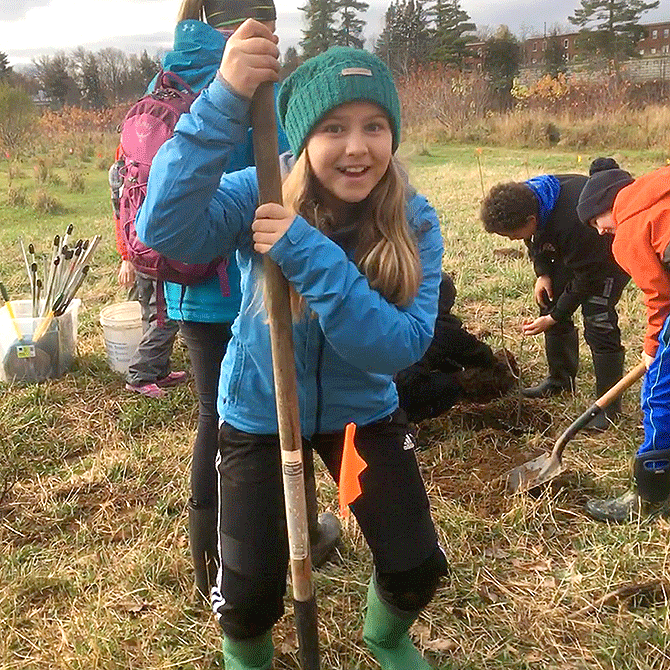Student Power
Students Lead the Way to Greener Schools
Student leaders are found in every province and at every grade level. Meet some of the youth who are leading their schools to take positive action.
As the consensus among scientists who suggest urgent action on the climate crisis grows, it is often students who are leading the way to making our schools – and our world – more sustainable. How can educators help kids and youth pursue their interest in sustainability and implement their creative ideas? We spoke with students from three different schools to see what works where they learn.
Nina Tran, Lee Frketich, Konrad Jasman and Summer Thomas
Westmount Secondary School, Hamilton, Ont.
Lesson: Stand back and let them lead
The members of Westmount Secondary School’s Eco Ninjas environmental activism team have done a lot to make their school a greener and more sustainable place.
They’ve created pollinator and rain gardens, grown fruit and vegetables on campus, and facilitated and expanded recycling and composting in their school. And a big reason that they’ve been able to accomplish all of this – aside from their own ideas and initiative – is thanks to supportive advisory staff like Mr. Holmes, says Grade 13 student Nina Tran, one of the team’s members.
“Mr. Holmes has been brilliant in understanding the perfect balance between pushing students and allowing them to stumble, to fall and to learn,” she explains. “He allows the Westmount Eco Ninjas to be almost completely a student-led, student-built and student-charged team. This is a key role in our success as a club, and our success as individuals.”
Tran’s fellow team member, Lee Frketich, age 17, echoes this: “We’d come to him with these crazy ideas and half of a plan, and rather than shutting us down, he’d just be like, ‘If you think you’re able to do that, go for it.’ Or he’d look at our plan and if he saw major issues with it, rather than telling us no, he’d sit down with us and say, ‘Well, have you considered this?’ And get us to go back and make sure that our plans had the best chance of succeeding while letting us lead.”
Eco Ninjas member Summer Thomas, 18, says this willingness to let students find their own way with support is key to empowering them. “One thing that we have actually noticed, which is a bit surprising, is that the more a teacher steps back and lets the students do their own thing, the better,” she says. “Obviously, guidance is great, and when a student is getting started on their project or if they request guidance then that’s a good time to step in, but teachers should largely step back and let the students kind of figure things out and learn through experience.”
One area that the Eco Ninjas needed help with was in navigating some of the bureaucracy that comes with making changes.
“We had some wonderful advisors in our club who really helped us push the limitations of what could happen,” says Tran. “If we didn’t have an advisor who was willing to explore how we could jump through those hoops, or if we didn’t have administration that was willing to help us in certain methods, then we wouldn’t have been able to grow in the way we have.”
But even with this support, the Eco Ninjas haven’t been able to overcome all of their obstacles. Two projects that haven’t been completed yet because of various policy roadblocks are the installation of solar panels at the school and an update of their school board’s waste management policy. And so, in an effort to make these changes happen and also to be taken more seriously by people, increase their resources and capacity, bypass the limitations of what they can do as a school club, and be able to work with other groups in their community and share ideas to support other schools’ environmental clubs, Tran and Frketich created a non-profit.
If your organization, school district or faculty of education is an EdCan member (see the list here), you can enjoy unlimited access to our online content! Click here to create your online account.
Incorporated in January 2019, the Environmental Community of Hamilton Students – or ECHS, as they prefer to be called – has about 15 official members. Tran and Frketich are its executive directors, as are Thomas and fellow Westmount student Konrad Jasman, who both became a part of ECHS soon after it was founded.
“We were finding a large void where the voice of youth should be,” explains Thomas. “And we wanted to make sure that there was space in the environmental community in Hamilton where the youth voice is listened to and seriously considered,” adds Frketich.
So, the bottom line, whether it’s in a school environment or in the community, is that the way to support students who are motivated to be part of changing the world is to offer space for them to thrive, they explain. “Kids are already inspired and they have ideas and things that they want to do, so give them a place at the table and somewhere where they know they can share those crazy ideas or come up with a proposal and actually see that happen,” says Frketich.
Jason Pang
Richmond Secondary School, Richmond, B.C.

Lesson: Share your passion
Jason Pang, 17, is a veteran of student environmental work. Pang spent three years as president of his high school’s Green Team, the environmental sustainability club at Richmond Secondary School, and was also a green ambassador for the city of Richmond. He is currently in his first year at the University of British Columbia, where he’s doing a Bachelor of Science in Global Resource Systems, which focuses on the world’s resources and how we can properly manage them sustainably.
When Pang first joined a school green team in Grade 8, it was one that was well-established with lots of support from enthusiastic and knowledgeable staff who students could turn to for help and feedback. But when he transferred schools to Richmond Secondary in Grade 10, he found there was lot of work to do on this front. “When I joined I pretty much had to start everything from scratch,” he recalls. But Richmond’s Green Team got a boost when Eugene Harrison began teaching at the school when Pang was in Grade 11. “She really changed the club,” explains Pang. “Because she was so passionate about the issue I was really inspired by her and she really took time to listen to me. Although I had the ideas, Ms. Harrison really brought those ideas together.”
Pang says this teacher helped Green Team members navigate policy and guided them as they ran events (the team did a lot of fundraising and teaching events). But she also brought learning into the equation. “She taught us a lot about scientific approaches toward environmental sustainability and how we can calculate our change, and that was really impactful,” he says.
Two standout projects organized by the Green Team were an electronic waste campaign where the class that collected the most waste won a pizza party, and a spirit week they hosted called Waste Reduction Week. The latter had three goals: improve the school’s waste diversion rate, educate students and staff on the impacts of waste and how that it affects us, and involve students as much as possible. One way they met that last goal was by meeting students where their passions were. For instance, they roped in the school’s business students to run zero waste pop-up shops on campus. “My school drinks a lot of bubble tea, and we wanted to tackle that issue by selling reusable bubble tea cups. That was a really big hit!” he says.
Both efforts won grants at the B.C. Green Games, a competition run by Science World.
While these events and others were successful, Ms. Harrison inspired Pang to go even bigger before he graduated. That project? Getting solar panels for the school. That involved a ton of fundraising, presentations to the school district, being part of an advisory committee, and learning about the engineering behind the panels.
While the initial plan was to have the Green Team pay for the solar panels by fundraising and applying for community grants, after many meetings with school district officials the district surprisingly decided to cover the cost.
“Seeing that I was able to make this impact was the brightest moment I had in high school,” says Pang.
The money they had already raised for the solar panels was used to create a pollinator garden and outdoor learning space at their school that they partnered with the David Suzuki Foundation to build this past summer.
What advice does Pang have for staff who want to support students who do this work? Listen to them and guide them through potential issues, but also model environmentally sustainable approaches and try to work this concept into all lessons. “There are a lot of ways that teachers have the opportunity make environmental sustainability part of the school curriculum,” he notes.
Mackenzie Klinker
Park Street Elementary, Fredericton, N.B.

Lesson: Be nimble and jump when you see a spark of interest
A thousand trees will be planted in New Brunswick, thanks to ten-year-old Mackenzie Klinker.
“Our school motto is ‘The best possible place to grow’.”
In late September, Klinker’s mom showed her a short film about student climate activist Greta Thunberg and then took her to the Fredericton climate strike the following day, which spurred the Grade 5 student at Park Street Elementary to launch her first environmental campaign. “I watched a video with my mom on climate change and it said that 200 species of animals go extinct every day. I didn’t know that and I really didn’t like that,” she recalls. “Our school motto is ‘The best possible place to grow,’ so I thought, ‘Then we should grow something.’ That’s why I decided I want to plant a thousand trees and help fight climate change.”
Klinker first took action by writing a letter to her school’s principal, Rien Meesters, vice principal, Mme. Gauvin, and teacher, Mme. Howlett, asking for their support.
Mme. Howlett helped find a solution. She suggested reaching out to the Nashwaak Watershed Association. They selected the types of trees to plant and the location: the bank of the Nashwaak River.
And so, just a few weeks later, Klinker and her whole class headed out to the river and planted 29 trees. They also got a science lesson in the outing, too, in that they learned about seeds and got to go critter dipping, where they used a net to find creatures, like backswimmers, in a nearby pond.
Now that the first batch of trees has been planted, they have 971 to go. And the whole school plans to help her meet that goal when the weather is warmer. “The rest of the staff are planning for each classroom to do something in the spring,” explains Meesters.
And Klinker wants to keep it going even longer: “I’d like it to continue every single year here at Park Street,” she says.
This whole project came together in a lightning-quick fashion, in part due to the responsiveness of the staff at Park Street and their willingness to act on Klinker’s suggestions.
Her advice for teachers?
“Kids can help think of ideas and what they would like to do. Then the teachers can support them for their projects and help make them possible,” she suggests. She also wants teachers to bring climate change education into the classroom when kids are younger. And she’s got a message for all adults about listening to kids on climate action: “It’s our future, so we want them to do stuff so we can have a good future.”
Photos: courtesy of Nina Tran, Olwyn Klinker and Jason Pang
First published in Education Canada, March 2020
